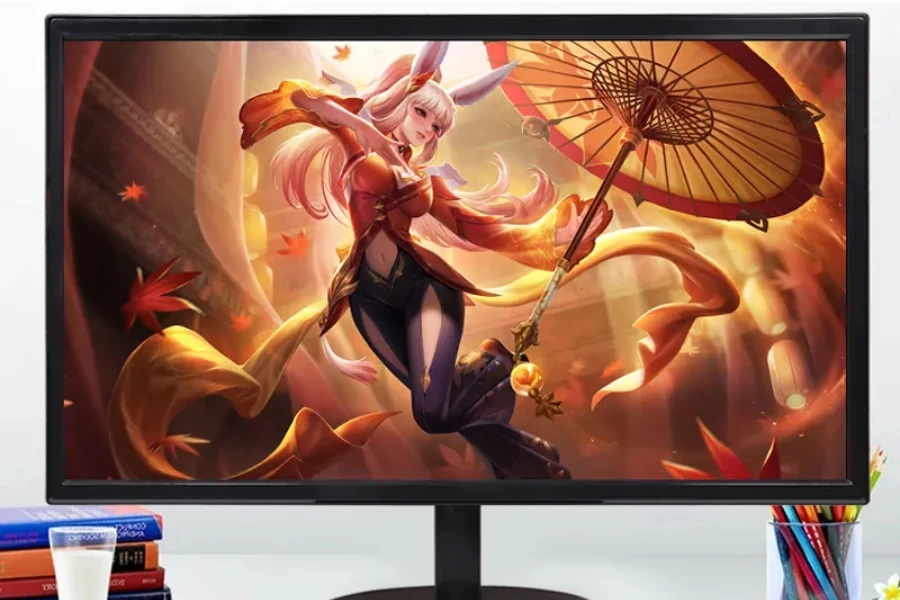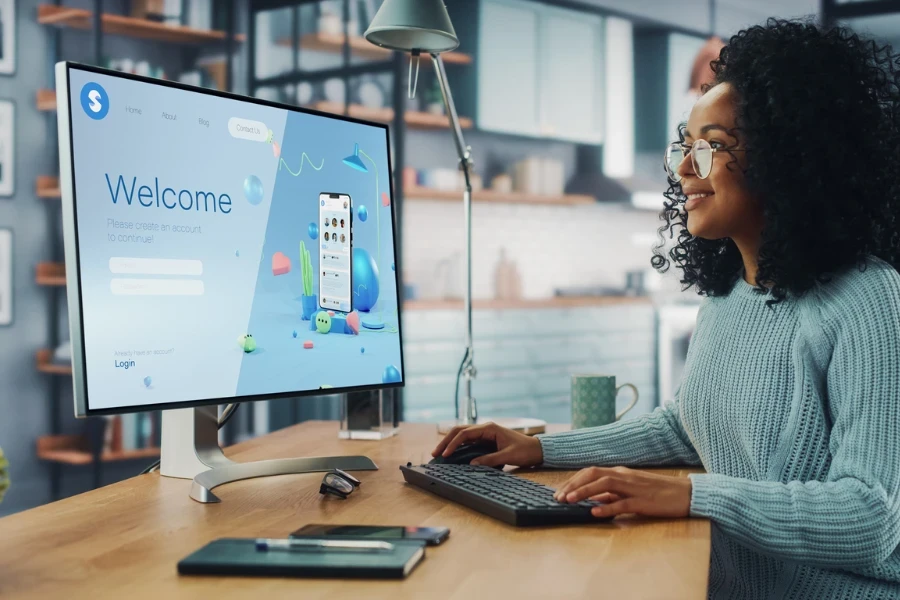In the bustling tech ecosystem of 2024, LCD monitors stand as pivotal tools, enhancing productivity, entertainment, and digital creativity. With the rapid evolution of display technologies, these monitors now offer unparalleled visual experiences, catering to diverse professional needs—from graphic designers craving color accuracy to gamers seeking fluid motion. As businesses strive to meet the demands of an ever-discerning clientele, understanding the nuances of the LCD landscape becomes paramount.
Table of Contents
2024 market overview: Riding the wave of LCD evolution
Precision selection: Key considerations for LCD monitors
Leading the pack: Top LCD monitors and their standout features
Conclusion
2024 market overview: Riding the wave of LCD evolution

Global demand and consumption patterns
The global LCD monitor market has witnessed rapid growth in recent years. Experts currently value the LCD monitor market at approximately US$ 157.8 billion in 2023. They anticipate this market to grow to an estimated US$ 187.8 billion by 2028. This growth is expected to occur at a compound annual growth rate (CAGR) of around 4.2% from 2023 to 2028.
The digital age has seen the computer monitor evolve from a mere display tool to an essential component of our daily lives, be it for work, gaming, or streaming content. As the demand for monitors grows, so does the diversity in user preferences. While some prioritize display quality, others emphasize features and connectivity. The market offers a plethora of choices, from standard 1080p screens to impressive 4K ultra wides. The baseline for monitor size has shifted to 24 inches, with 1080p resolution being the most cost-effective. However, for those seeking a larger display, options beyond 30 inches are readily available, with some even nearing the 50-inch mark.
Technological advancements and innovations
Resolution plays a pivotal role in determining the visual experience a monitor offers. While 1080p remains a popular choice, the industry is witnessing a shift towards higher resolutions. 1440p, often referred to as Quad HD or QHD is gaining traction among gamers for its enhanced visuals. 4K, with its detailed imagery, is becoming more affordable, though it demands a robust graphics card for optimal performance. On the horizon, we have 8K displays, such as Samsung’s Odyssey Neo G9, which promise unparalleled clarity but are still a few years away from becoming mainstream.
In terms of display technology, LED monitors dominate the market. However, OLED displays, known for their vibrant colors and low input lag, are becoming increasingly popular. QLED (Quantum Dot Light-Emitting Diode), primarily promoted by Samsung, offers exceptional brightness. Another emerging technology is mini-LED, which enhances brightness and contrast in LCD screens.
The type of panel a monitor uses significantly impacts its performance. While TN (Twisted Nematic) panels are favored for their fast response times, IPS (In-Plane Switching) panels are renowned for their color accuracy and wide viewing angles. VA (Vertical Alignment) panels strike a balance between the two, offering good colors with decent response times.
Price dynamics and supply chain insights
The monitor market is highly competitive, leading to a continuous drop in prices, especially with the advent of newer technologies. For instance, as 4K monitors become more commonplace, their prices have seen a substantial reduction. However, cutting-edge technologies like OLED and QLED still command a premium. The supply chain’s intricacies, from the sourcing of raw materials to the manufacturing of advanced panels, play a crucial role in determining the final price of a monitor. Factors such as technological innovations, economies of scale, and market demand dynamics influence pricing strategies.
Precision selection: Key considerations for LCD monitors

Panel types and their relevance
When selecting an LCD monitor, the panel type plays a pivotal role in determining the visual experience. Different panel types cater to different audiences:
TN (Twisted Nematic): Historically the most common, TN panels offer swift response times, making them a favorite among gamers. However, they might display slightly washed-out colors and have limited viewing angles. They are often the most affordable option.
VA (Vertical Alignment): VA panels provide better colors and viewing angles than TN but can sometimes exhibit ghosting. They strike a balance between color accuracy and response times, making them suitable for a broader audience.
IPS (In-Plane Switching): IPS panels are often considered the gold standard for color accuracy and wide viewing angles. They are ideal for professionals who prioritize color fidelity, though they might have slightly slower response times than TN panels.
OLED: Known for their intense contrast, beautiful visuals, and low input lag, OLED displays are becoming increasingly popular. They offer an unparalleled visual experience but come at a premium price.
QLED (Quantum Dot Light-Emitting Diode): Promoted mainly by Samsung, QLED displays are known for their supreme brightness and are more common in TVs than monitors.
Each panel type has its strengths and weaknesses, and the choice largely depends on the user’s primary activities on the PC. For instance, esports enthusiasts might prioritize speed and opt for TN, while graphic designers might lean towards IPS for its color accuracy.
Size, resolution, and aspect ratios
The size of the monitor is often the first consideration for buyers. While anything below 22 inches is generally not recommended, 24 inches has become a popular baseline, offering excellent visuals at 1080p. Monitors stretching 27 inches diagonally have gained popularity, with some even nearing 50 inches, like the 48-inch LG UltraGear OLED. However, for most users, sizes between 24 and 32 inches strike the right balance between screen real estate and affordability.
Resolution is another critical factor. While 1080p remains a baseline, 1440p (or Quad HD/QHD) is becoming a sweet spot, especially for gamers. 4K offers a more detailed visual experience, but it demands a powerful graphics card. There are also ultrawide monitors with unique aspect ratios like 21:9, offering broader views of content, making them favorites among gamers and content creators.
HDR, brightness, and color accuracy
High Dynamic Range (HDR) can significantly enhance visuals, but its effectiveness depends on the monitor’s brightness. Most monitors have a brightness of around 300 to 350 nits, but high-end models can exceed 700 nits. HDR versions like HDR10+ offer advanced content display. Contrast ratios, which indicate the difference between the whitest white and the blackest black, are also crucial for color differentiation.

Refresh rates and gaming compatibility
The refresh rate, measured in hertz (Hz), determines how often the monitor updates the image. While 60Hz is standard, higher refresh rates like 120Hz to 144Hz offer smoother visuals, especially in fast-paced games. Some monitors even support up to 240Hz or 500Hz, though the latter is rare and requires a powerful graphics card. Response time, which indicates image transition speed, is also vital for fast-paced games.
Connectivity options and future trends
Modern monitors come equipped with various ports like HDMI, DisplayPort, and USB-C. While HDMI 1.4 supports 4K resolution, HDMI 2.0 is needed for a 60Hz refresh rate at 4K. DisplayPort 1.4 can handle up to 8K at 60Hz and 4K at up to 200Hz. USB-C, though versatile, is not as capable as DisplayPort connections. Additionally, design considerations like tilt, rotation, and mounting options, as well as features like built-in webcams, can influence the buying decision.
In the ever-evolving world of technology, understanding these key considerations ensures that business professionals and online retailers make informed decisions when selecting LCD monitors.
Leading the pack: Top LCD monitors and their standout features

In the bustling world of LCD monitors, certain models have risen to the top, offering exceptional value and performance across various price points.
Budget-friendly champions
For those on a tighter budget, the Samsung T35F stands out with its reliable performance and crisp visuals, making it a favorite among businesses looking for cost-effective solutions. Similarly, the LG 24GL600F, with its rapid response time and vibrant colors, offers a lot without breaking the bank. These models prove that quality doesn’t always come with a hefty price tag.
Mid-range marvels
Navigating the mid-range segment, the HP U28 4K HDR Monitor emerges as a frontrunner, boasting impeccable clarity and color accuracy. The Gigabyte G27QC, with its curved design and immersive experience, is another notable contender. Not to be left out, the BenQ 27-inch QHD HDR Monitor offers a balanced blend of performance and aesthetics, making it a top choice for businesses seeking a bit of flair without compromising on functionality.

Premium powerhouses
For businesses that prioritize premium quality, the ViewSonic ColorPro VP2786-4K is a testament to excellence in display technology, offering unparalleled color accuracy and sharpness. The Dell G3223Q and Dell P3223QE, with their robust features and sleek designs, cater to professionals who demand nothing but the best from their equipment.
Special mentions: Ultrawide, portable, and luxury monitors
Diving into niche segments, ultrawide monitors have seen a surge in popularity, offering expansive screen real estate for multitasking. Portable monitors cater to the on-the-go professionals, while luxury monitors, with their opulent designs and cutting-edge features, are for those who desire exclusivity.
Conclusion
The LCD monitor landscape is ever-evolving, with technological advancements ushering in new possibilities. For businesses, staying ahead means not just embracing these changes but also anticipating future trends. By understanding the nuances of the market, from budget-friendly options to premium powerhouses, retailers can make informed decisions, ensuring their inventory remains relevant and competitive. The key lies in continuous learning and adaptation, ensuring that as the world of LCD monitors progresses, so do the businesses that rely on them.



